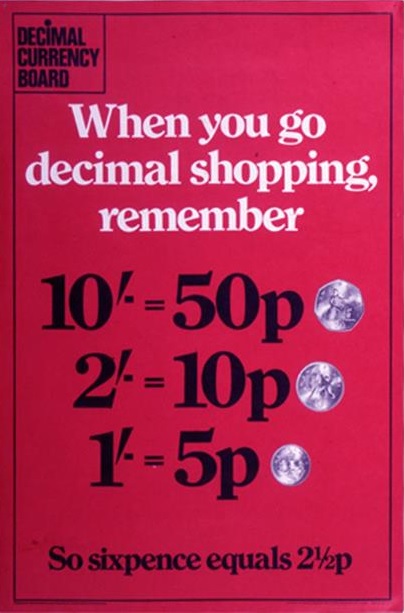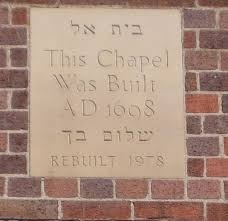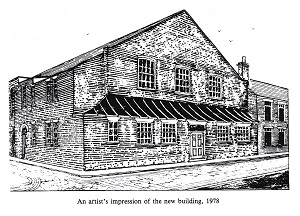 In October 1970 the Lodge Initiation fee increased from £31/10/- to £35/-/- and the Annual Subscription increased from £6/10 to £10/-/-. (It is perhaps an indication of the rate of inflation that in 1975 the Initiation fee was increased to £50, the Joining fee to £15.50 and the annual subscription for members admitted prior to 1919 increased to £12. (After March 1976 there were no such members, they having retired to the Grand Lodge Above..) In 1977 the Initiation Fee was doubled to £100.)
In October 1970 the Lodge Initiation fee increased from £31/10/- to £35/-/- and the Annual Subscription increased from £6/10 to £10/-/-. (It is perhaps an indication of the rate of inflation that in 1975 the Initiation fee was increased to £50, the Joining fee to £15.50 and the annual subscription for members admitted prior to 1919 increased to £12. (After March 1976 there were no such members, they having retired to the Grand Lodge Above..) In 1977 the Initiation Fee was doubled to £100.)
On 15th February 1971 the currency in the UK was changed from sterling to the decimal system in order to be in line with Europe and other countries. The old penny, halfpenny and threepenny bit were officially taken out of circulation in August 1971. For any readers who can remember the farthing, it was demonetised at the end of 1960 but had seen little use in the years before that.
Once again, Neil Armstrong paints a vivid picture of life in the UK.
It was the world of Bell-bottom Flares, Space hoppers and Chopper bikes; Yet of all post-war decades, the 1970s undoubtedly had the cruellest press. ridiculed and despised It would end in a desperately difficult period for Britain.
 It marked a reckoning for a country that had been too complacent for too long, basking in the sunshine of post-war affluence, and indifferent to the fact, that foreign competitors had not only caught up, but were leaving Britain behind. And though the Prime Minister Harold Wilson got the country back to work, it came at a price. With inflation at almost 30%, it became necessary for a demeaning bailout from the International Monetary Fund (IMF).
It marked a reckoning for a country that had been too complacent for too long, basking in the sunshine of post-war affluence, and indifferent to the fact, that foreign competitors had not only caught up, but were leaving Britain behind. And though the Prime Minister Harold Wilson got the country back to work, it came at a price. With inflation at almost 30%, it became necessary for a demeaning bailout from the International Monetary Fund (IMF).
Yet, for most ordinary people, the 1970s brought new experiences that their parents and grandparents could barely have imagined. The Rediffusion colour television in the lounge, the Copper Bronze coloured Ford Capri in the drive, and those obligatory painfully tight flared trousers! But, the most obvious example was the package holiday abroad, which thirty years earlier would have seemed like something from science fiction. For even relatively low-paid working-class families, holidays no longer meant Withernsea or Scarborough but Spain and Majorca. "Abroad", once regarded with suspicion, now meant two weeks of sun, sea, and sangria.
 Dinner parties had become extremely popular, the swanky hostess trolley in the kitchen, warming new fashionable ‘foreign’ dishes like Spaghetti Bolognese. Spaghetti novices spent their evenings chasing their food around the plate attempting to catch it in their fork and spoon while trying to avoid splattering themselves with thick tomato sauce. Washed down with bottles of Blue Nun, Chianti, and Mateus Rose – it was the height of sophistication!
Dinner parties had become extremely popular, the swanky hostess trolley in the kitchen, warming new fashionable ‘foreign’ dishes like Spaghetti Bolognese. Spaghetti novices spent their evenings chasing their food around the plate attempting to catch it in their fork and spoon while trying to avoid splattering themselves with thick tomato sauce. Washed down with bottles of Blue Nun, Chianti, and Mateus Rose – it was the height of sophistication!
 Chains of restaurants such as the Berni Inns began to appear in every British town and city, serving those classic 1970s favourites of Melon or Prawn Cocktail, Mixed Grill or Steak, with Black Forest Gateau or Lemon Meringue Pie for dessert. Similarly, ‘Going out for a curry,’ our love affair with chicken tikka masala grew. A perfect illustration of the way Britain absorbed and adapted external influences; masala sauce being added to satisfy the taste of home-grown customers.
Chains of restaurants such as the Berni Inns began to appear in every British town and city, serving those classic 1970s favourites of Melon or Prawn Cocktail, Mixed Grill or Steak, with Black Forest Gateau or Lemon Meringue Pie for dessert. Similarly, ‘Going out for a curry,’ our love affair with chicken tikka masala grew. A perfect illustration of the way Britain absorbed and adapted external influences; masala sauce being added to satisfy the taste of home-grown customers.
However, the decade would end in the infamous ‘Winter of Discontent.’’ When more than 2,000 strikes erupted across Britain, as workers rejected the Government’s attempts to curtail wage increases with an incomes policy.
On 24th June 1974 W Bro C G Hopley was appointed Secretary, his predecessor, W Bro S N Ryan PPJGW having served for sixteen years in that office. (Bro Ryan had been initiated in 1935 and became WM in 1942 and was Lodge Secretary 1958 to 1974. His name appears on many honours boards, including the Chapter, the Mark, Knights Templar and the Ancient and Accepted Rite, He died in January 1978.) C G Hopley continued the history recorded by J R Ellerby.
His masterly summary of the saga of the Compulsary Purchase Order which he included in the April minutes for1977 in a memorandum is reproduced here.
"Closure of the Minerva Lodge Premises for Reconstruction"
It is deemed to be opportune to record herein a brief resume of events leading up to the vacating of the premises whilst major alterations and improvements are carried out, and the details which follow are in the main taken from the Lodge Committee Minutes.
On the 15th February 1967 it had been reported that a plan had been prepared and was on view in the Guildhall indicating that the Lodge premises were due for demolition if the Corporation were succesful in gaining approval of the Ministry, and on 21st February 1968 a Notice of Compulsory Purchase had been served on the Secretary and Trustees.
On the 5th November 1968 the first positive steps were taken as a result of the Compulsory Purchase Order when it was decided we would take every possible step to retain possession of the premises, and this was followed on the 8th December 1972 after the Public Enquiry had been held, at which we were represented, to oppose the C. P. O. when we decided to form a Building Committee to draw up plans to deal with alterations to the premises as soon as the Corporation had given the go-ahead by letter. The members of this sub-committee were W. Bros. E. O. Selby, K. M. Brown, J. E. Eltherington, S. L. Webb, and A. J. G. Healey as its secretary. They had authority to seek whatever assistance was necessary from members of the Minerva Lodge and Sister Lodge tenants. This sub committee held its first on 28th February 1973, and agreed no further action could be taken until the Hull Corporation had been notified in writing that the C. P. O. had been cancelled.
On 22 November 1973 it was reported that the premises had been selected for inclusion in the list of "Architectural and Historical Buildings" (Class II star) and that the sub committee could proceed with its plans accordingly. A survey of the building, especially the foundations, was carried out at a cost of £500 which was most generously met by one of our members (W. Bro. J. E. Eltherington.)

 2 from Minerva Craft
2 from Minerva Craft
1 from Minerva Chapter
2 from Hull Old Grammarian Craft
1 from Hull Old Grammarian Chapter
1 from Humber Mark
1 from A. Y. C. R. Knight Templars
1 from Humber Knights Templars
1 from A. Y. C. R Rose Croix
1 from Wyke Rose Croix
W. Bro. E. O. Selby also gave a report of the Building sub committee (a copy of which is in the Lodge Committee Minute Book) which gave birth to the basic scheme for the reconstruction and improvements of the premesis, viz: the kitchen, dining room and bar to be removed to the ground floor. Mr. A. Lazenby was appointed the architect and from that point developed the project which resulted in a contract being placed with Robinson & Sawdon Ltd. who took over the premises on 4th April 1977 to commence the work, and which resulted in the premises being managed by the Minerva Masonic Hall Association Ltd. on a long term lease, the Association comprising representatives of the users for the mutual benefit of all their members.
In those plans the driving force has been W. Bro. Edgar Owen Selby as Chairman, with the able assistance and co-operation of the committees mentioned in the extracts from the Lodge Committee Minutes of 8th December 1972 and 8th October 1974.
In order to prepare the building for hand-over to the contractors, and to preserve our furniture, fittings, and belongngs, as well as those of Sister Lodge tenants it became necessary to strip down the various rooms and store everything possible in the Temple until such time as we could re-occupy the reconstructed building, and to this end the following of our brethren voluntarily carried out this work on the evenings of 30th March to 2nd April - their names appear alphabetically: W. Bros T. C. Forth, W. H. Houston, C. G. Hopley, F. L. Ledgard, G. Mell, G. E. Scarr, J. S. Train, S. I. Webb, Bros. E. W. Cudbertson, F. W. and P. J. Duckwith, E. B. Matthews, A. W. Mawer, G. J. Miles, R. Sanderson and G. D. Steward.
 Bro. R. Sanderson moved the cooking apparatus from the kitchen and also constructed and fitted a most efficient steel structure which completely sealed off the Temple, and Bro G. J. Miles provided a fork truck which greatly facilitated the moving of heavy objects.
Bro. R. Sanderson moved the cooking apparatus from the kitchen and also constructed and fitted a most efficient steel structure which completely sealed off the Temple, and Bro G. J. Miles provided a fork truck which greatly facilitated the moving of heavy objects.
Until such time as we were able to resume our activities in the reconstructed premises meetings were held at Beverley by courtesy of the Constitutional Lodge No. 294.
It is not without interest that when we re-occupy the premises the entrance to the Lodge will be from Prince Street, which was its address when the Temple was originally built in 1802.
The work of the Building sub committee and the Minerva Masonic Hall Association Ltd. referred to in this memorandum are recorded in their respective Minutes by their Hon. Secretary, W. Bro. A. J. G. Healy.
C. G. Hopley, Secretary, 13. 4. 1977
 After deferring to the other Secretary, Bro Hopley included two articles from the local paper before appending an addendum about the rebuilding of the old Chapel west wall:
After deferring to the other Secretary, Bro Hopley included two articles from the local paper before appending an addendum about the rebuilding of the old Chapel west wall:
"One of the problems which emerged during the work was the discovery of a 13 inch bulge in the west elevation which resulted in the wall having to be completely rebuilt. This wall, part of the old Chapel purchased in 1874, contained a plaque, partly indistinguishable, but which we know contained date of building and certain Hebrew characters, which as a result of some research, it was possible to incorporate into the  west wall a new plaque with the characters and the wording: "This Chapel Was Built AD 1698 REBUILT 1978." The Hebrew inscription is translated (according to George
west wall a new plaque with the characters and the wording: "This Chapel Was Built AD 1698 REBUILT 1978." The Hebrew inscription is translated (according to George  Hadley's History of Kingston upon Hull in 1788:)
Hadley's History of Kingston upon Hull in 1788:)
BETH ELL* - The House of God
SHALUM BECH - Peace be with thee
* By this word we may observe the affinity between the Hebrew, Arabic, Turkish and Hindustani languages in all which Allah signified God.

In 1979 the Forster & Andrews organ, which had been in need of an overhaul for some time (it had been locally built and installed in 1882 but no action had been taken on account of the Compulsory Purchase Order) was dismantled, cleaned and reassembled under the direction of Bro R Proud from the Lodge of St Michael 7833, who had been trained as an organ builder. It was a race against time, but the work was completed the day before the Lodge Installation.
In December 1979 a clipping from the local newsapaer is included with the minutes refering to the restoration of the delapidated buildings in Prince Street but the artist's sketch bears little resemblance to the actuality.

